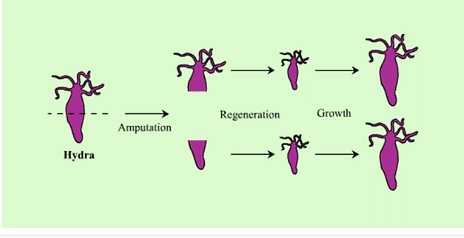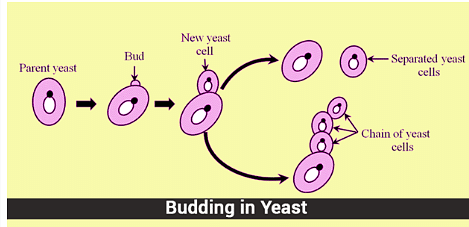Class 10 Exam > Class 10 Questions > What is difference between budding in yeast a...
Start Learning for Free
What is difference between budding in yeast and hydra
?
?
Verified Answer
What is difference between budding in yeast and hydra?
Budding in Hydra:
In case of budding in Hydra, a small bud is developed from the body of parent hydra through repeated mitotic division of its cells. The small bud then derives nourishment from the parent hydra and begins to grow. The mature bud starts developing small tentacles and mouth. When the bud completely matures into a new hydra, it detaches itself from the parent hydra and becomes an independent organism.

Budding in yeast:
In case of budding in yeast, a small bud appears as an outgrowth from the parent body. After this, the nucleus of the parent yeast elongates and gets divided into two parts. One of these nuclei migrates into the bud. The newly created bud divides and grows into a new yeast cell.

 This question is part of UPSC exam. View all Class 10 courses
This question is part of UPSC exam. View all Class 10 courses
Most Upvoted Answer
What is difference between budding in yeast and hydra?
Budding of Hydra : in case of budding in Hydra, a small bud is developed from the body of parent hydra through repeated mitotic division of its cells. The small bud then derives nourishment from the parent hydra and begins to grow. The mature bud starts developing small tentacles and mouth. When the bud completely matures into a new hydra, it detaches itself from the parent hydra and becomes an independent organism
Budding of yeast :In case of budding in yeast, a small bud appears as an outgrowth from the parent body. After this, the nucleus of the parent yeast elongates and gets divided into two parts. One of these nuclei migrates into the bud. The newly created bud divides and grows into a new yeast cell.
Budding of yeast :In case of budding in yeast, a small bud appears as an outgrowth from the parent body. After this, the nucleus of the parent yeast elongates and gets divided into two parts. One of these nuclei migrates into the bud. The newly created bud divides and grows into a new yeast cell.
Community Answer
What is difference between budding in yeast and hydra?
Introduction:
Budding is a form of asexual reproduction that occurs in both yeast and hydra. Although the basic process of budding is similar in both organisms, there are notable differences in the details and outcomes of budding between yeast and hydra.
Budding in Yeast:
- Budding in yeast is a type of asexual reproduction where a small bud or outgrowth forms on the parent cell and eventually detaches to become a new individual.
- The bud starts as a small protrusion on the parent cell, which grows in size over time.
- As the bud enlarges, a nucleus from the parent cell migrates into the bud, ensuring that the genetic material is passed on to the new individual.
- The bud continues to grow until it reaches a certain size, after which it detaches from the parent cell and becomes an independent yeast cell.
- This process allows yeast to rapidly multiply and colonize new environments.
Budding in Hydra:
- In hydra, budding is also a form of asexual reproduction, but it involves the development of a bud that eventually grows into a new individual.
- The process begins with the formation of a small outgrowth or bud on the body of the parent hydra.
- The bud gradually develops into a miniature hydra, complete with tentacles and a mouth.
- Unlike yeast, the bud in hydra remains attached to the parent organism for a period of time, forming a connection known as the "peduncle."
- As the bud matures, it receives nutrients and oxygen from the parent hydra through this connection.
- Eventually, the bud detaches from the parent hydra, and the peduncle closes up, resulting in the formation of a new, independent hydra.
Differences:
1. Detachment:
- In yeast, the bud detaches from the parent cell once it reaches a certain size, becoming an independent individual.
- In hydra, the bud remains attached to the parent organism for a period of time before detaching to become a separate entity.
2. Size:
- Yeast buds are relatively smaller compared to the parent cell, and they grow in size before detaching.
- Hydra buds grow into miniature versions of the parent organism, complete with tentacles and a mouth.
3. Nutrient Supply:
- Yeast buds do not receive any direct nutrient supply from the parent cell. They rely on external sources for sustenance.
- Hydra buds remain connected to the parent hydra through the peduncle, allowing them to receive nutrients and oxygen directly from the parent organism.
4. Independence:
- Yeast buds become independent individuals as soon as they detach from the parent cell.
- Hydra buds initially rely on the parent organism for support but eventually detach to become fully independent hydra.
Conclusion:
In conclusion, although budding is a form of asexual reproduction observed in both yeast and hydra, there are significant differences in the process. Yeast buds detach from the parent cell once they reach a certain size, while hydra buds remain connected to the parent organism through a peduncle. Hydra buds grow into miniature versions of the parent hydra, whereas yeast buds are relatively smaller. Additionally, hydra buds receive direct nutrient supply from the parent organism, while yeast buds rely on external sources. Understanding these differences enhances our knowledge of the diverse mechanisms of asexual reproduction in different organisms.
Budding is a form of asexual reproduction that occurs in both yeast and hydra. Although the basic process of budding is similar in both organisms, there are notable differences in the details and outcomes of budding between yeast and hydra.
Budding in Yeast:
- Budding in yeast is a type of asexual reproduction where a small bud or outgrowth forms on the parent cell and eventually detaches to become a new individual.
- The bud starts as a small protrusion on the parent cell, which grows in size over time.
- As the bud enlarges, a nucleus from the parent cell migrates into the bud, ensuring that the genetic material is passed on to the new individual.
- The bud continues to grow until it reaches a certain size, after which it detaches from the parent cell and becomes an independent yeast cell.
- This process allows yeast to rapidly multiply and colonize new environments.
Budding in Hydra:
- In hydra, budding is also a form of asexual reproduction, but it involves the development of a bud that eventually grows into a new individual.
- The process begins with the formation of a small outgrowth or bud on the body of the parent hydra.
- The bud gradually develops into a miniature hydra, complete with tentacles and a mouth.
- Unlike yeast, the bud in hydra remains attached to the parent organism for a period of time, forming a connection known as the "peduncle."
- As the bud matures, it receives nutrients and oxygen from the parent hydra through this connection.
- Eventually, the bud detaches from the parent hydra, and the peduncle closes up, resulting in the formation of a new, independent hydra.
Differences:
1. Detachment:
- In yeast, the bud detaches from the parent cell once it reaches a certain size, becoming an independent individual.
- In hydra, the bud remains attached to the parent organism for a period of time before detaching to become a separate entity.
2. Size:
- Yeast buds are relatively smaller compared to the parent cell, and they grow in size before detaching.
- Hydra buds grow into miniature versions of the parent organism, complete with tentacles and a mouth.
3. Nutrient Supply:
- Yeast buds do not receive any direct nutrient supply from the parent cell. They rely on external sources for sustenance.
- Hydra buds remain connected to the parent hydra through the peduncle, allowing them to receive nutrients and oxygen directly from the parent organism.
4. Independence:
- Yeast buds become independent individuals as soon as they detach from the parent cell.
- Hydra buds initially rely on the parent organism for support but eventually detach to become fully independent hydra.
Conclusion:
In conclusion, although budding is a form of asexual reproduction observed in both yeast and hydra, there are significant differences in the process. Yeast buds detach from the parent cell once they reach a certain size, while hydra buds remain connected to the parent organism through a peduncle. Hydra buds grow into miniature versions of the parent hydra, whereas yeast buds are relatively smaller. Additionally, hydra buds receive direct nutrient supply from the parent organism, while yeast buds rely on external sources. Understanding these differences enhances our knowledge of the diverse mechanisms of asexual reproduction in different organisms.
Attention Class 10 Students!
To make sure you are not studying endlessly, EduRev has designed Class 10 study material, with Structured Courses, Videos, & Test Series. Plus get personalized analysis, doubt solving and improvement plans to achieve a great score in Class 10.

|
Explore Courses for Class 10 exam
|

|
Similar Class 10 Doubts
What is difference between budding in yeast and hydra?
Question Description
What is difference between budding in yeast and hydra? for Class 10 2024 is part of Class 10 preparation. The Question and answers have been prepared according to the Class 10 exam syllabus. Information about What is difference between budding in yeast and hydra? covers all topics & solutions for Class 10 2024 Exam. Find important definitions, questions, meanings, examples, exercises and tests below for What is difference between budding in yeast and hydra?.
What is difference between budding in yeast and hydra? for Class 10 2024 is part of Class 10 preparation. The Question and answers have been prepared according to the Class 10 exam syllabus. Information about What is difference between budding in yeast and hydra? covers all topics & solutions for Class 10 2024 Exam. Find important definitions, questions, meanings, examples, exercises and tests below for What is difference between budding in yeast and hydra?.
Solutions for What is difference between budding in yeast and hydra? in English & in Hindi are available as part of our courses for Class 10.
Download more important topics, notes, lectures and mock test series for Class 10 Exam by signing up for free.
Here you can find the meaning of What is difference between budding in yeast and hydra? defined & explained in the simplest way possible. Besides giving the explanation of
What is difference between budding in yeast and hydra?, a detailed solution for What is difference between budding in yeast and hydra? has been provided alongside types of What is difference between budding in yeast and hydra? theory, EduRev gives you an
ample number of questions to practice What is difference between budding in yeast and hydra? tests, examples and also practice Class 10 tests.

|
Explore Courses for Class 10 exam
|

|
Suggested Free Tests
Signup for Free!
Signup to see your scores go up within 7 days! Learn & Practice with 1000+ FREE Notes, Videos & Tests.

























